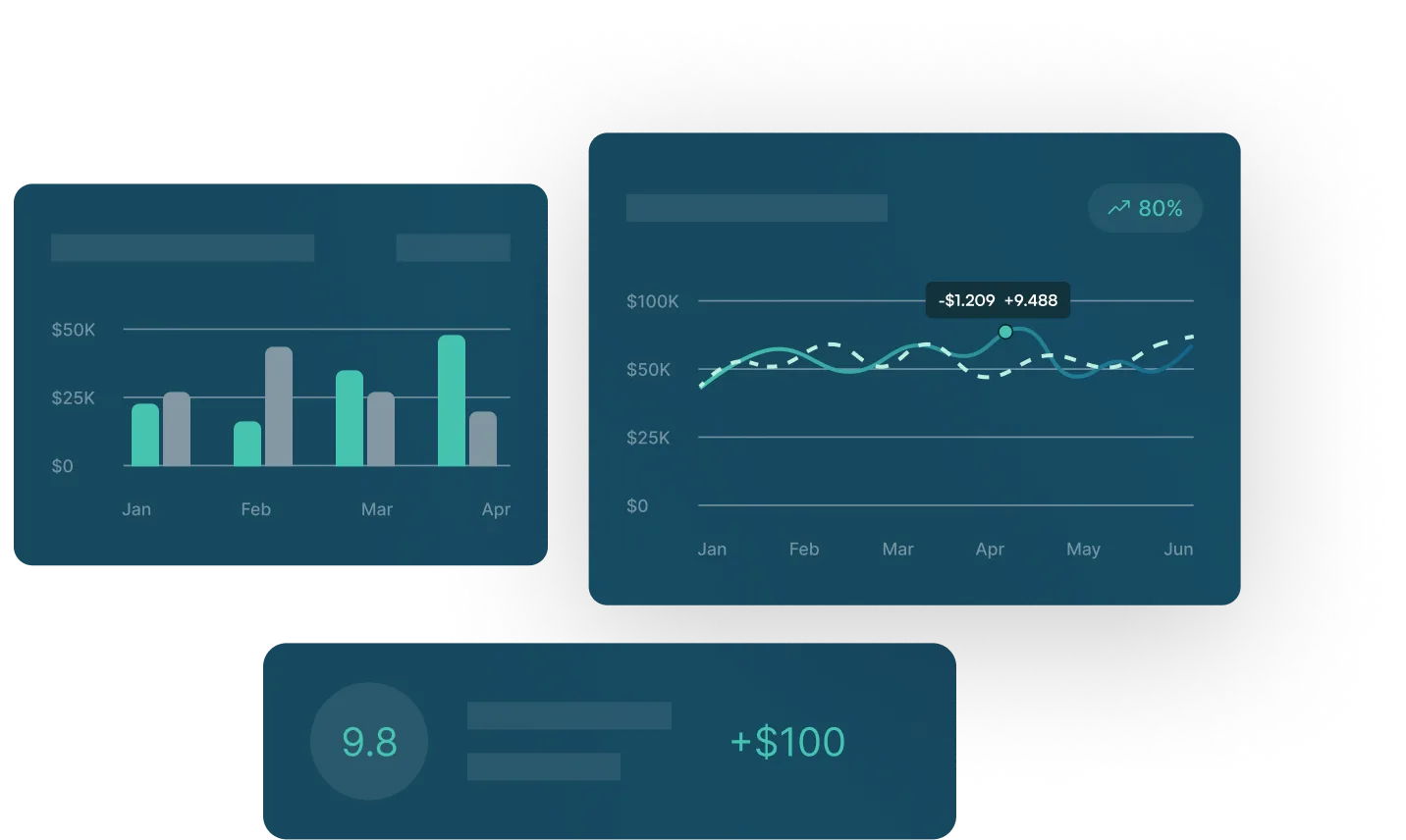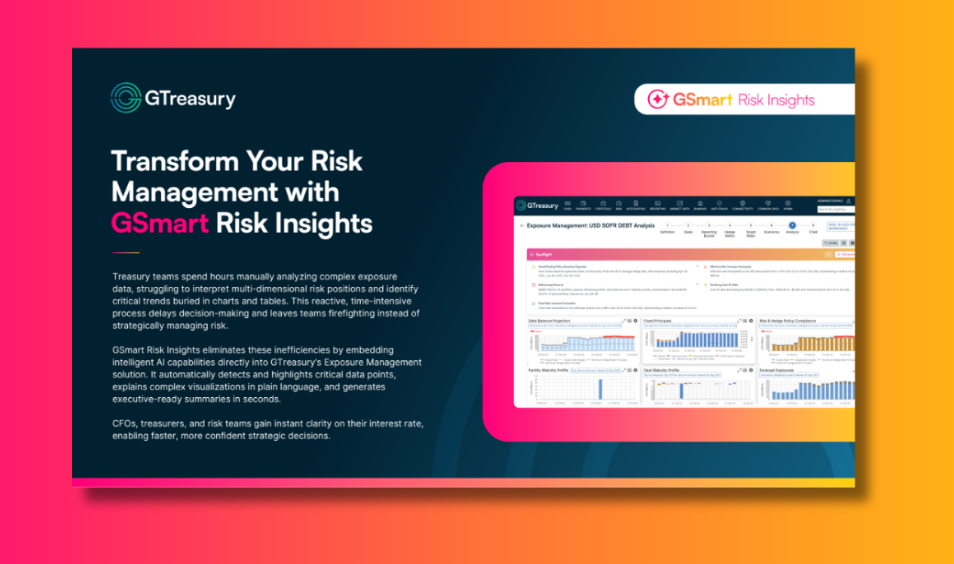Four Types of Risk Exposure Your Treasury Team Can’t Afford to Miss
.jpg)
.jpg)
Treasury teams face a constant barrage of financial risks. From shifting interest rates to unpredictable counterparties, every decision carries potential exposure.
Understanding the key types of risk exposure is the first step to protecting liquidity and making strong strategic moves. Let’s break down the four types of risk exposures your treasury team needs to keep on its radar.
1. Market Risk Exposure
What is Market Risk Exposure?
Market risk exposure is the potential for financial loss due to changes in market variables, like interest rates or shifts in commodity prices. When these factors move unexpectedly, they can impact the value of your assets and future cash flows. For treasury teams, market risk exposure is an everyday reality that influences everything from borrowing costs to hedging decisions.
Why Market Risk Exposure Matters
Even small market shifts can have a big impact on liquidity and profitability. A sudden rate hike can increase debt costs, while currency swings can distort your cash forecasts.
When treasurers can see and quantify this exposure in real time, they can make proactive moves to counteract the changes before volatility hits.
2. Credit Risk Exposure
What is Credit Risk Exposure?
Credit risk exposure is the potential for loss if a counterparty fails to meet its obligations. These counterparties can be a customer, supplier, or financial institution.
For treasury teams, that could mean delayed payments or other disruptions to financing arrangements. In short, it’s the risk that someone you rely on for cash inflows or liquidity doesn’t come through.
Why Credit Risk Exposure Matters
When a counterparty defaults, the ripple effects can hit every aspect of an organization’s finances. Cash positions, working capital, and even your organization’s credit rating could all be impacted.
Concentration in a few key counterparties or regions can magnify that risk. By monitoring creditworthiness and diversifying exposure, treasury teams can stay ahead of potential disruptions and maintain stability.
3. Liquidity Risk Exposure
What is Liquidity Risk Exposure?
Liquidity risk exposure is the threat of not having enough cash when your organization needs it. It’s what happens when short-term obligations come due, but available funds or credit lines fall short. For treasury teams, managing this exposure means balancing day-to-day cash needs with longer-term funding strategies.
Why Liquidity Risk Exposure Matters
A liquidity shortfall can quickly disrupt operations. It can also force companies to rely on expensive, last-minute borrowing. With accurate forecasting and clear contingency plans, treasury teams can avoid these crunches and keep liquidity flowing.
4. Operational Risk Exposure
What is Operational Risk Exposure?
Operational risk exposure is the potential for loss caused by internal failures, rather than external shortfalls. This might mean a data entry mistake that skews forecasts, a failed payment file, or a cyberattack that disrupts critical systems. Unlike market or credit risks, operational risk stems from how your organization runs day to day.
Why Operational Risk Exposure Matters
Even the best strategies can fail if processes and systems aren’t reliable. Operational issues can lead to financial losses, compliance breaches, or reputational damage. By automating manual tasks and ensuring robust security protocols, treasury teams can reduce these risks and build a more resilient operation.
Benefits of a Unified Risk Framework
Managing each type of risk separately can leave gaps and blind spots in your treasury operations. A unified risk framework brings all exposures together, providing a complete view that helps treasury teams make smarter, faster decisions. Here are some of the key benefits:
- Holistic Visibility: See all types of risk exposure in one place and make it easier to spot correlations, concentrations, and potential problem areas before they escalate.
- Proactive Decision-Making: With integrated data and analytics, treasury teams can anticipate market movements rather than reacting after the fact.
- Improved Forecasting Accuracy: A single framework allows for more precise cash flow and liquidity forecasts by incorporating all relevant risk factors.
- Enhanced Operational Efficiency: Centralized processes reduce manual work streamline reporting across departments.
- Stronger Risk Mitigation: By understanding interconnections between exposures, treasury teams can implement strategies that protect the organization more effectively and reduce overall risk.
Turning Risk Awareness into Action
Understanding the four key types of risk exposure is just the first step. The real value comes from taking that awareness and turning it into actionable insight.
With a unified platform like GTreasury, treasury teams gain complete visibility into all risk exposures, enabling proactive decision-making and more confident financial planning.
Four Types of Risk Exposure Your Treasury Team Can’t Afford to Miss
Treasury teams face a constant barrage of financial risks. From shifting interest rates to unpredictable counterparties, every decision carries potential exposure.
Understanding the key types of risk exposure is the first step to protecting liquidity and making strong strategic moves. Let’s break down the four types of risk exposures your treasury team needs to keep on its radar.
1. Market Risk Exposure
What is Market Risk Exposure?
Market risk exposure is the potential for financial loss due to changes in market variables, like interest rates or shifts in commodity prices. When these factors move unexpectedly, they can impact the value of your assets and future cash flows. For treasury teams, market risk exposure is an everyday reality that influences everything from borrowing costs to hedging decisions.
Why Market Risk Exposure Matters
Even small market shifts can have a big impact on liquidity and profitability. A sudden rate hike can increase debt costs, while currency swings can distort your cash forecasts.
When treasurers can see and quantify this exposure in real time, they can make proactive moves to counteract the changes before volatility hits.
2. Credit Risk Exposure
What is Credit Risk Exposure?
Credit risk exposure is the potential for loss if a counterparty fails to meet its obligations. These counterparties can be a customer, supplier, or financial institution.
For treasury teams, that could mean delayed payments or other disruptions to financing arrangements. In short, it’s the risk that someone you rely on for cash inflows or liquidity doesn’t come through.
Why Credit Risk Exposure Matters
When a counterparty defaults, the ripple effects can hit every aspect of an organization’s finances. Cash positions, working capital, and even your organization’s credit rating could all be impacted.
Concentration in a few key counterparties or regions can magnify that risk. By monitoring creditworthiness and diversifying exposure, treasury teams can stay ahead of potential disruptions and maintain stability.
3. Liquidity Risk Exposure
What is Liquidity Risk Exposure?
Liquidity risk exposure is the threat of not having enough cash when your organization needs it. It’s what happens when short-term obligations come due, but available funds or credit lines fall short. For treasury teams, managing this exposure means balancing day-to-day cash needs with longer-term funding strategies.
Why Liquidity Risk Exposure Matters
A liquidity shortfall can quickly disrupt operations. It can also force companies to rely on expensive, last-minute borrowing. With accurate forecasting and clear contingency plans, treasury teams can avoid these crunches and keep liquidity flowing.
4. Operational Risk Exposure
What is Operational Risk Exposure?
Operational risk exposure is the potential for loss caused by internal failures, rather than external shortfalls. This might mean a data entry mistake that skews forecasts, a failed payment file, or a cyberattack that disrupts critical systems. Unlike market or credit risks, operational risk stems from how your organization runs day to day.
Why Operational Risk Exposure Matters
Even the best strategies can fail if processes and systems aren’t reliable. Operational issues can lead to financial losses, compliance breaches, or reputational damage. By automating manual tasks and ensuring robust security protocols, treasury teams can reduce these risks and build a more resilient operation.
Benefits of a Unified Risk Framework
Managing each type of risk separately can leave gaps and blind spots in your treasury operations. A unified risk framework brings all exposures together, providing a complete view that helps treasury teams make smarter, faster decisions. Here are some of the key benefits:
- Holistic Visibility: See all types of risk exposure in one place and make it easier to spot correlations, concentrations, and potential problem areas before they escalate.
- Proactive Decision-Making: With integrated data and analytics, treasury teams can anticipate market movements rather than reacting after the fact.
- Improved Forecasting Accuracy: A single framework allows for more precise cash flow and liquidity forecasts by incorporating all relevant risk factors.
- Enhanced Operational Efficiency: Centralized processes reduce manual work streamline reporting across departments.
- Stronger Risk Mitigation: By understanding interconnections between exposures, treasury teams can implement strategies that protect the organization more effectively and reduce overall risk.
Turning Risk Awareness into Action
Understanding the four key types of risk exposure is just the first step. The real value comes from taking that awareness and turning it into actionable insight.
With a unified platform like GTreasury, treasury teams gain complete visibility into all risk exposures, enabling proactive decision-making and more confident financial planning.
.jpg)
Siehe GTreasury in Aktion
Nehmen Sie noch heute Kontakt mit unterstützenden Experten, umfassenden Lösungen und ungenutzten Möglichkeiten auf.






























.png)





.png)
.png)







.png)












.jpeg)

.jpeg)


.jpeg)







.jpeg)

.jpeg)





.jpeg)


.jpeg)

.jpeg)








.jpeg)







.jpg)

.jpg)





